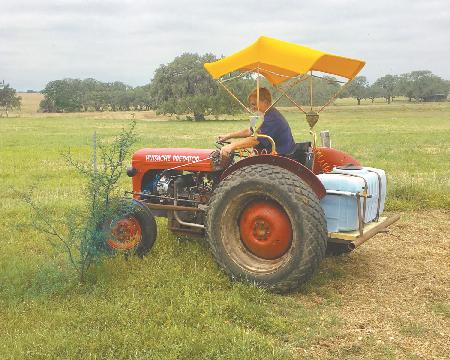Ferguson TO-20 Tractor Converted To Hydrostatic Drive

Bryan Albrecht, Goliad, Texas, needed an efficient way to get rid of invasive brush on his pasture and hay land.
He already had an old Ferguson TO-20 tractor with a worn out engine so he replaced the engine, converted the transmission to hydrostatic drive, and added a 50-gal. tank on back between the fenders. A belt-driven sprayer pump, mounted under the tractor, supplies herbicide to a pair of fender-mounted spray wands, one on each side of the driver, and to a boomless nozzle located behind the tank. The tractor's speed and direction is controlled with a single foot pedal.
He replaced the tractor's original 20 hp. engine with a 22 hp. V-twin engine that he bought at Harbor Freight. He also re-routed the tractor's muffler down low to direct exhaust away from the driver.
Albrecht's wife, Cyndy, named the tractor the Huisache Predator.
"She came up with the name because we have a real problem with an invasive species of thorny brush called Huisache, and this tractor is designed to go after it," says Albrecht. "Cyndy does most of the spraying. I figured that if she doesn't mind doing the work, the least I can do is build a spray rig for her that makes the job as pleasant as possible.
"We use the spray wands mostly during the fall to control brush, and the boomless nozzle in the spring to control weeds that grow around farm equipment in our barn yard.
"I like to weld and do various projects, but this was my first hydrostatic build. I was excited to see it come together."
He says the single foot pedal provides infinite forward and reverse control and is easy to use. "Cyndy can put the transmission in any of the tractor's four forward gears and rock the pedal forward for infinite control, from zero to a wide open speed. If she misses a bush and needs to back up, she can push down with her heel and go backward at the same speed without having to change gears."
He cut the tractor in front of the transmission case where the engine's clutch was coupled to the transmission, keeping the original transmission with its 4 forward gears, and mounted a hydraulic motor on the input shaft.
"The four gears are still there, but with the add-on foot pedal the operator has infinite speed control for each gear," says Albrecht. "The control lever for the hydraulic pump is located on the left side of the tractor and connected by a chain and sprocket assembly to the foot pedal, which is located on the right side. The operator uses the lever to control the flow and direction of oil to the hydraulic motor, which causes the tractor to speed up, slow down, or go forward or backward."
He mounted a 6-roller sprayer pump under the tractor that?s belt-driven off the engine. "This tractor now has a live pto, so the sprayer pump keeps going even when the driver changes gears or stops and backs up. A magnetic clutch is used to control the spray pump and is activated by flipping a switch on the dash," says Albrecht.
He bought a pair of replacement spray wands at Tractor Supply Company and connected a Harbor Freight self-coiling, retractable air hose to each one. The hoses are attached to a pipe that runs from the pump back to the tank. The boomless nozzle screws onto an outlet at the back of the pipe and is controlled by turning a valve.
Albrecht bought the engine at Harbor Freight and the hydraulic pump and motor, and other miscellaneous parts needed to make the hydrostatic conversion, from Surplus Center.
"I didn't keep any receipts on purpose, because I didn't want to know what my total cost would be for this project. I paid $700 for the engine and am sure I spent a total of about $2,000," says Albrecht.
